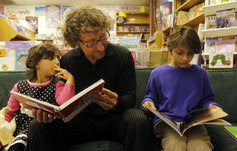I argued then that the misdiagnosing and subsequent counterproductive treatment of the disorder was the single biggest issue confounding the child welfare system.
I still think that’s true. I don’t see any evidence that the situation is improving. In fact, it’s reached a crisis point and we need to make this issue more a part of our national dialogue.
Reactive Attachment Disorder is caused when an infant doesn’t bond properly to its primary caregiver. This basic loss results in ongoing feelings of rage, shame, lack of trust, a morbid fear of attaching to anyone, an inability to understand cause and effect thinking and a compulsive need to control everyone and every situation.
Extreme cases are typically caused by chronic neglect in early infancy followed by years of instability -- an all-too-common formula for children in foster care.
Without proper intervention, these children have little chance of meaningful relationships. In foster care, they often bounce from foster home to foster home as one well-meaning foster parent after another gives up because of the severity of the child's behavior problems; each move exacerbates the condition. Children with RAD are masterful at rejecting caregivers and burning bridges.
They get labeled “unadoptable” and frequently spend their entire childhoods in foster care, a system designed to be temporary. The far end of the continuum includes children who are violent, destructive, unmanageable, dangerous and sociopathic.
Experiences early in life have a tremendously important impact on the developing brain. We recognize now that it doesn’t take a fist or a blunt object to cause brain damage.
In the cerebral cortex (where language, emotion and logic are developed), for example, trauma or lack of stimulation during infancy leads to the underdevelopment of neurotransmitters in that region. Consequently, this section of the brain is actually smaller in abused, neglected children than in healthy children. Traumatized infants secrete abnormally high amounts of stress hormones which have myriad adverse and long-term effects, as well. So, when a child with RAD seems incapable of trust or empathy or remorse, there’s good reason to believe that its etiology is neurological in nature and not just willful disobedience.
However, traditional insight-oriented, relationship-based, cognitive/behavioral therapies are ineffective in treating the disorder, and in some ways counterproductive. As are typical parenting methods. Without proper treatment, children with compromised attachment continue to struggle in virtually all settings: home, school, residential treatment programs, etc. That’s the big problem: only a small percentage of the children who need specialized treatment for the disorder are receiving it. We insist on putting square pegs in round holes and shaking our heads at its futility.
When I was on the road, everywhere I went, workshop participants complained about lack of resources for these children. We need more clinicians trained in an attachment model; we need more accurate diagnosing. These children are frequently misdiagnosed because their symptoms can look like a lot of different disorders, Bipolar Disorder and ADHD, for example. We waste a lot of precious time going down the wrong path with these kids. Key players system-wide need a better understanding of the nuances of the disorder including social workers, judges, pediatricians, children’s attorneys and advocates, not just mental health workers.
Caregivers need special training to be effective. Behavior management strategies such as positive reinforcement, time out, token economies and other standard parenting techniques just don’t work with these children. Too often, foster and adoptive parents lose faith in the mental health and social service systems. They feel helpless and hopeless regarding any positive outcome and they give up. Who can blame them?
And, there’s no escaping politics. Especially in child welfare, treatment often comes down to a battle among the state, the courts and insurance companies over who’s responsible for payment -- particularly in communities where specialized treatment isn’t readily available and the only option is sending the child out-of-state for expensive treatment. Too often, the child doesn’t get the help he or she needs.
Instead he wastes time in the office of an ill-equipped therapist. We then blame the child for not making progress. To me, it’s analogous to prescribing Tylenol for a child with diabetes who needs insulin to survive, and then absolving yourself of responsibility once you do. It’s unconscionable, but it’s what I see a lot of communities doing.
It is estimated that RAD affects 3-6% of the overall population. But it is rampant within the child welfare system, I think. There’s no way to know for sure how many of the approximately 600,000 foster children in the US are suffering from RAD, but I’m positive the disorder is flying under the radar and contributing significantly to the chaotic state of our foster care system. I personally know dozens of children who’ve been in ten, fifteen, even 30 different foster homes. Again, I attribute much of problem to undiagnosed and untreated RAD.
The prognosis is poor for children with RAD who don’t get the help they need as they reach adulthood and are released from protective care. Approximately 20,000 foster children age out of the system each year, often with no familial connections and nowhere to go. Too often they end up homeless, incarcerated, institutionalized and dead. And, they’re raising the next generation of attachment-compromised children. Inadequate mental health care is one of the primary reasons for such dismal outcomes.
If the State is going to be so bold as to remove a child from his parents because they’re incapable, then it has a responsibility to provide the highest quality of services for that child. The child is already at a tremendous disadvantage. The State, acting in loco parentis, should expect and demand the same high level of medical, mental health and educational services as any good parent would for their child. Unfortunately, that’s not happening.
The consequences for society are more far-reaching than one might realize. We already know that a vast majority of habitual felons were abused as children. I don’t think it takes much to extrapolate that a large percentage of them are adults with undiagnosed and untreated RAD. Our prisons are filled with RAD kids grown up, I believe.
It makes sense when you consider that children with RAD typically lack self-control, have antisocial attitudes and behavior, are aggressive and violent and lack empathy, compassion and remorse. Isn’t that exactly the same set of adjectives we use to describe hardened criminals?
Like most disorders, prevention and early intervention are the best solutions. I recommend learning more about RAD by visiting the website for the Association for Treatment and Training of Attachment of Children (ATTACh) at www.attach.org, where you’ll also be able to locate registered attachment therapists and clinics in your area.
It comes down to priorities. We know what the problem is and what the solution is. What’s left to be seen is whether we’ll actually devote the energy and resources to fix it.
 |
| Neglected child's brain underdeveloped |
















